



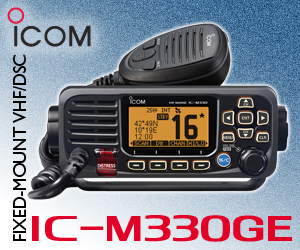

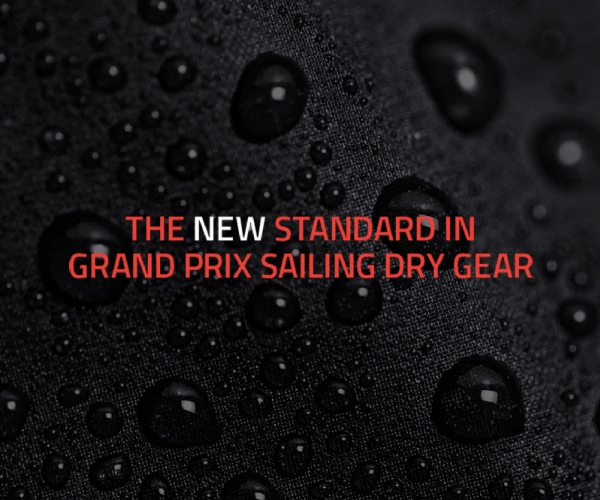





| Laser 28 - Excellent example of this great design Hamble le rice |
 |
| Rossiter Pintail Mortagne sur Gironde, near Bordeaux |
 |
| Laser 140101 Tynemouth |
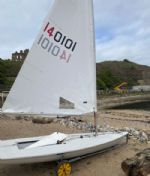 |
List classes of boat for sale |
GRF's rig school |
Post Reply 
|
Page <1234 13> |
| Author | |
Isis 
Really should get out more 

Joined: 01 Sep 05 Online Status: Offline Posts: 2753 |
 Post Options Post Options
 Quote Quote  Reply Reply
 Topic: GRF's rig school Topic: GRF's rig schoolPosted: 22 Nov 09 at 1:29pm |
|
The rigs are different because they perform totaly different functions, not because sitting down sailors just arent paying attention.
The fact is that the development in both dinghies and boards pales into insignificance next to the time and money spent trying to tweak that extra 0.1knot out of a grand prix leadmine... |
|
 |
|
rodney 
Really should get out more 
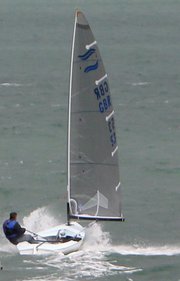
Joined: 26 Feb 09 Location: United Kingdom Online Status: Offline Posts: 915 |
 Post Options Post Options
 Quote Quote  Reply Reply
 Posted: 22 Nov 09 at 1:34pm Posted: 22 Nov 09 at 1:34pm |
|
some here might die of shock!
|
|
 |
|
Chris 249 
Really should get out more 

Joined: 10 May 04 Online Status: Offline Posts: 2041 |
 Post Options Post Options
 Quote Quote  Reply Reply
 Posted: 22 Nov 09 at 1:43pm Posted: 22 Nov 09 at 1:43pm |
|
As a windsurfer and boat sailor, I have to agree with the dinghy sailors.
Dinghy sails are different because they have to be different, so that they can cover a wider wind range and achieve the lift needed to drive a larger hull in winds that are often lighter. Sure, a Moth foiler sail looks like a windsurfer sail - but that is because the lift/drag characteristics of a foiler are closer to those of a windsurfer, not because foiler sails are 'better'. There are quite a lot of things that dinghy sails do better than board sails, and vice versa. You can't compare them directly, any more than you can compare the wing of an airliner to that of a fighter. Grumpf, you are COMPLETELY wrong about dinghy sailors not taking care to match masts and sails. They have been very well aware of varying mast bend since at least the 1950s; so aware that they could see the bend in their wooden Finn masts change according to humidity. This is all documented in black and white, and has been for decades, since Von Hutschler's breakthrough with bendy rigs in Stars in the '30s. |
|
 |
|
G.R.F. 
Really should get out more 
Joined: 10 Aug 08 Location: United Kingdom Online Status: Offline Posts: 4028 |
 Post Options Post Options
 Quote Quote  Reply Reply
 Posted: 22 Nov 09 at 1:51pm Posted: 22 Nov 09 at 1:51pm |
|
Windsurfing sails and masts perform in different arenas, some for fun
leisure application, some for competition, some for One Design. But the basic essential ingredient is always matching or more accurately mis-matching by design, the luff curve of the sail to the bend curve of the mast. Windsurf masts are pre bent to assist in the stiffening process, load them one way and they're less likely to distort the other way. The subject matter that raised this discussion was the mast of the DI which bends both ways. It's not pre bent, we're supposed to believe on the one hand it bends off sideways upwind to cope with spilling gusts from a big fat headed sail, whilst then not bending forward because a bloody great kite has been hoisted up it? Or when bending forward it some how miraculously holds the exact shape to continue to provide the stable leading edge that big fat headed sail would need. Well my simple point was that it doesn't it's not efficient, whatever is gained by hoisting the spinnaker is lost by fall off from the main, maybe not in equal amount, but significant. So I now have to spend time explaining to y'all the fact that I just happen to have thirty plus years studying these rigs in order to what? Justify an opinion? |
|
 |
|
rodney 
Really should get out more 

Joined: 26 Feb 09 Location: United Kingdom Online Status: Offline Posts: 915 |
 Post Options Post Options
 Quote Quote  Reply Reply
 Posted: 22 Nov 09 at 2:01pm Posted: 22 Nov 09 at 2:01pm |
|
Thanks for the mention of Finn masts. 60 years of development of the Finn rig incorporates a lot of experience. We supply a considerable number of Finn sails throughout the world and North One Design supply many more, all are cut to match the individual mast to the mm and every Finn mast has different bend. Rodney |
|
 |
|
Phil eltringham 
Really should get out more 
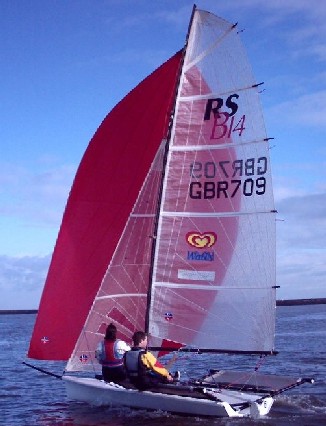
Joined: 16 Mar 04 Location: England/Hitchin Online Status: Offline Posts: 1105 |
 Post Options Post Options
 Quote Quote  Reply Reply
 Posted: 22 Nov 09 at 2:56pm Posted: 22 Nov 09 at 2:56pm |
|
Ok, I've avoided rushing into this reply, partly because I needed some sleep last night, and partly because I quite enjoyed going back through my old notes and books. I will try and keep this as coherent as possible. Now I appreciate that much of what you say is somewhat tongue in cheek, and perhaps a little facetious, however it worries me that people will take it to be true when your scientific basis is wrong. I will freely admit that my knowledge of fluid mechanics is not complete, but I like to think I have a reasonable enough grasp of the basics to correct some of your mistakes. There seem to be a large number of things you are moaning about without actually putting together a serious argument for your reasoning behind any of them, you flit to the next problem you perceive before you have finished exploring the previous one. That aside I will try and deal with each of your points in turn. For your first comments on the D-One rig we first need to consider two things, firstly the shot was taken, in what looks like a decent breeze, some of your friends are out in the background so it must be north of 20 knots, i.e.: the top end of the boats operating range, and secondly, it is a photo - a single moment in time, and is with limited context and thus only viable for the most basic of analysis. You question the need for the upper roach on the mainsail leech when it is twisted off and the mast is bending forwards of its upwind position and to leeward. There are a number of reasons for this. Firstly being at the top end of the wind range it is designed for it will be bending significantly, now that is not to say it cannot be engineered to deal with higher winds, but if that is not the design brief then it cannot be said to be a failure if it does not do something it is not required to do. Next you comment that the mast is "bent out of shape". Out of which shape? It’s upwind shape, its static shape, its unloaded shape? Of course it will be, it has a kite flying off it and it has less mainsheet induced leech tension as it has been eased for a start. (I am trying to work through your points in order, however I will jump forward to another of your arguments relating to flexible masts and progressive bend). Looking at the two photos of downwind sailing the point of maximum bend is around or just above the second batten up, and after the third batten up the mast is virtually straight again, this is the signature of the modern "progressively" bending mast, where the aim is for it to be more like a bow rather than having a floppy tip - which I agree with you is not 'fast'. You say that you can hold up 12meter rigs by hand, I don't deny that, but I somewhat doubt you'd be holding up something that size as the breeze increased. There would be no point, the biggest drag factor on a windsurfer is the aero drag on the person sailing it, you simply need enough sail to get you consistently fully planing and then extra sail area is going to be more hindrance than help, but you knew that already, or people would only have a 12 meter sail, and not bother with the rest of them. You say that sails are, or should be, cut to deal with variations in wind speed, if this is the case, why have a mast that will bend at all? Curved yes, but you could make pre-bent windsurf mast that was completely rigid and would not 'flap about' and yet this is not the case, I suggest that having some flex in the mast, to allow the rig to react to gusts and lulls is vital to make the whole thing handle able. Next you make a point about windsurfers having been working on mast bend and its relation to luff curve for thirty years, is that all?? Yachts have been experimenting with bend characteristics, and matching luff curves for over 100 years, but you knew that already, didn't you?! Progressive twist is nothing new either, it has been the goal for decades, all the different ideas have been working towards this in some way. The pace of development has been different between the two disciplines, I grant you. Boats have moved slower, in part because of their size and relative expense to work through a number of ideas. But more so (and this is especially true for dinghies for which the size-cost issue is less) because of class rules. Windsurfers for the most part have developed free of prescriptive class rules, and because they are smaller and cheaper it has been far easier to work through a vast array of ideas at full scale, and as such they have, to some extent, stolen a march on boats in terms of rig development, especially for high speed. I will treat your comments ("Have forgotten more about sail design than clearly the simpleton that built that rig will ever know. " and "As an efficient device for dealing with a range of conditions, given the level of sophistication the other control features of the hull potentially bring to bear, it is quite frankly a joke.") with the contempt they deserve. So far I have not read a single thing which you have written that implies you have any real understanding of the mechanics of sail design, please do prove me wrong though. The very fact that there is not too much going on at deck level to control the rig implies that the rig its self is doing a good job of looking after its self. The very fact that you mention laminar flow around foils in water means you really do not understand the structure of water, let alone fluid mechanics that well at all. I will let you (look it up) and while you are at it I suggest you have a look at Reynolds number, and its calculation too. As for the leech being in tension, I would agree that in those shots there is not enough, but as Tim and I have already discussed, learning the correct amount of mainsheet which is required to achieve that is a process which is ongoing, and is matter of operation, not design, because unlike a windsurf rig, this can be adjusted (main and kicker) far more easilly as you go along. This, by the way is my next research project, trying to understand what exactly happens to the tip vortex when you have a square head main which is moving around. Much as I would love to do this with RANS code I don't think I'm going to be able to access a computer big enough to do that so it’s going to be a bit more simplified for now. I'll let you know how I get on. Happy to accept all polite critisism and correction. Phil |
|
|
FLAT IS FAST!
Shifts Happen |
|
 |
|
Guests 
Guest Group 
|
 Post Options Post Options
 Quote Quote  Reply Reply
 Posted: 22 Nov 09 at 2:57pm Posted: 22 Nov 09 at 2:57pm |
|
You're (GRF) allowed to have opinions it's just the way dish out the stuff.... I bet you don't do the food shop...it would take you all day getting round the isles...."that's rubbish that is, where's the manager?"... ahhhh that's why they invented self service tills then! Nobody in this whole forum takes your boat as an example of how everything is wrong in the world and applies that warped logic to all "opinions" in all other threads, related or not. Perhaps your 30 years of experience should have been put to good use in boat development.....perhaps if you were involved in the dev you may be happy....perhaps not. I can't wait to hear what you have to say about your next boat, hells teeth, they better get that right. Glad I don't build boats Edited by timg |
|
 |
|
Jon711 
Far too distracted from work 

Joined: 04 May 07 Location: United Kingdom Online Status: Offline Posts: 465 |
 Post Options Post Options
 Quote Quote  Reply Reply
 Posted: 22 Nov 09 at 3:05pm Posted: 22 Nov 09 at 3:05pm |
|
Sorry Phil gave up reaing halfway through your post, too long.....
|
|
 |
|
Guests 
Guest Group 
|
 Post Options Post Options
 Quote Quote  Reply Reply
 Posted: 22 Nov 09 at 3:08pm Posted: 22 Nov 09 at 3:08pm |
|
Blimey Phil....there's an explanation! I think you may have been up all night typing it let alone thinking it. FYI when I came ashore someone in the boat park mentioned it gusted 25knots while I was out, although it was a steady 17 i reckon Edited by timg |
|
 |
|
G.R.F. 
Really should get out more 
Joined: 10 Aug 08 Location: United Kingdom Online Status: Offline Posts: 4028 |
 Post Options Post Options
 Quote Quote  Reply Reply
 Posted: 22 Nov 09 at 3:32pm Posted: 22 Nov 09 at 3:32pm |
Get into the context of the discussion, I'll humour you since you know a little of what I'm trying to get across, the context of this discussion is "Flying a Kite from an unstayed rig which has been designed to be bendy to depower a fat head sail." Now my other experiences have been that the masts have exactly not been considered when the sails has been designed, now they are my personal experiences, I dare say FinnSailors shaved wood off the masts to greater and lessor degree. But we are living in changing times, as dinghy world (read the beginning of the post) begins to come to terms with the greater speeds with increasigly forward apparent wind vectors, and some are not dealing with it. I maintain the rig of the D1 has not dealt with the issue.. Hence this discussion has come about. So how would I have dealt with the issue? If it had to be an unstayed rig? 1st I'd have had a mast designed to be unidirectional in it's bend, and 2nd I'd have controlled the for-aft bend to twist off the sail up wind using luff curve mis match a la sailboard rig.rather than permittng sideways bend under load. That for aft loaded pre bend would have helped support the kite. But then I'm not pretending to be a boat designer - am I? And this, isn't 20 knots.. 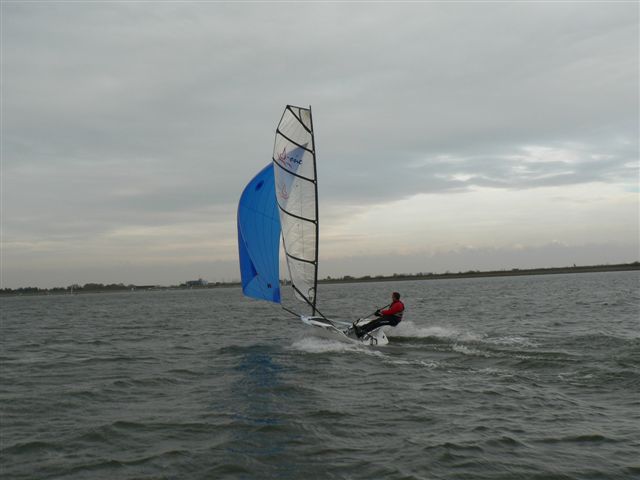
I'd say it's barely fifteen.. Phil, there are a lot of points you make, a lot I'm not about to dispute, it will however take a bit of time to go through them one at a time, will you be able to stay awake long enough tonight? Edited by G.R.F. |
|
 |
|
Post Reply 
|
Page <1234 13> |
| Forum Jump | Forum Permissions  You cannot post new topics in this forum You cannot reply to topics in this forum You cannot delete your posts in this forum You cannot edit your posts in this forum You cannot create polls in this forum You cannot vote in polls in this forum |
Copyright ©2001-2010 Web Wiz
Change your personal settings, or read our privacy policy











 Printable Version
Printable Version Delicious
Delicious Digg
Digg Facebook
Facebook Furl
Furl Google
Google MySpace
MySpace Newsvine
Newsvine reddit
reddit StumbleUpon
StumbleUpon Twitter
Twitter Windows Live
Windows Live Yahoo Bookmarks
Yahoo Bookmarks Topic Options
Topic Options
